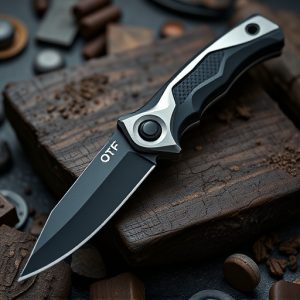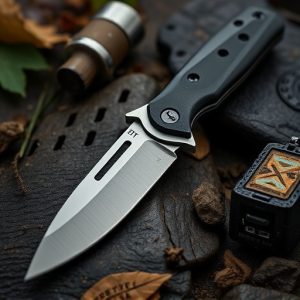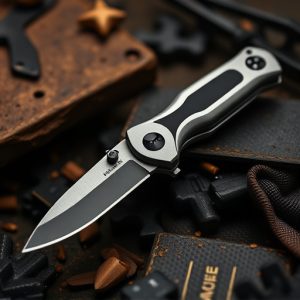Unlocking the Mechanics and Legality of OTF Automatic Knives
The One-Time-Flip (OTF) automatic knife is a highly engineered tool characterized by its rapid depl…….
The One-Time-Flip (OTF) automatic knife is a highly engineered tool characterized by its rapid deployment via a torsion bar system, activated with a single handle button press. These knives feature robust locking mechanisms to keep the blade securely open, ensuring both safety and usability. They are crafted from high-quality materials for superior precision and control, with ergonomic designs that prioritize durability and comfort in both the stainless steel blades and handles. The OTF knife has evolved significantly, transitioning from a novelty to a reliable tool for various applications, with improvements made to springs, locking mechanisms, and overall build quality to enhance reliability. Today's OTF automatic knives come with safety features, sleek designs, and a range of blade options, establishing them as practical tools rather than mere collectibles. Advancements in materials science have led to lighter and more durable knives that resist environmental factors. The legal status of OTF knives varies by jurisdiction, demanding knowledge of local laws, age restrictions, and carry limitations. Responsible ownership includes secure storage, adherence to legal use parameters, and understanding the ethical implications of their use. Prospective owners should consult legal resources or local law enforcement for the most current information on regulations and ensure they handle these knives with due respect, recognizing both their functional capabilities and the potential consequences in sensitive contexts.
OTF automatic knives represent a blend of precision engineering and practical functionality, making them both a tool for professionals and enthusiasts alike. This article delves into the intricate mechanisms that define an OTF automatic knife, its evolution from a novelty to a modern-day essential, and the legal frameworks governing their ownership. We explore the key features that set high-quality OTFs apart, offer guidance on maintenance, and discuss their role in everyday carry practices. Additionally, we compare OTFs with other folding knife mechanisms, highlight advancements in technology, and provide insights into selecting the ideal OTF for your needs. Whether for self-defense, survival, or daily tasks, understanding the nuances of OTF automatic knives is crucial for anyone considering adding one to their collection. Join us as we navigate the world of OTF automatics, examining their design, ergonomics, and aesthetic appeal across various environments and uses.
Understanding the OTF Automatic Knife: Mechanisms and Functionality
An OTF, or One-Time-Flip automatic knife, stands as a marvel of engineering within the realm of cutting tools. Its core functionality lies in its seamless deployment of the blade with a single action. The mechanism that enables this is a torsion bar system, whereupon pressing a button located on the handle, the bar releases its stored energy, flipping the knife’s blade out into an open position swiftly and reliably. This design eliminates the need for manual thumb studs or rings typically found on traditional flip knives. The OTF automatic knife features a locking system that secures the blade in place once it is fully extended, ensuring both safety and usability. Users can engage with the blade confidently, knowing it will not close unexpectedly during use.
The functionality of an OTF knife extends beyond its rapid deployment; it also offers a smooth and precise action due to the high-quality materials and meticulous construction. The blade itself is often crafted from durable stainless steel, offering both corrosion resistance and strength. The handle is ergonomically designed to provide a firm grip during operation, which is crucial for both safety and control. The OTF automatic knife’s complexity lies not only in its ability to open quickly but also in the balance between these components to ensure the knife remains compact and portable. This balance is achieved through precise engineering, making the OTF automatic knife a reliable tool for various tasks that require a swift and efficient cutting solution.
The Evolution of the OTF Automatic Knife: From Concept to Modern-Day Tool
The concept of an OTF, or one-time-flipping, automatic knife has undergone a remarkable evolution since its inception, marking a significant milestone in the history of knife design and functionality. Initially conceived as a novel mechanism for quick deployment of a blade, the OTF knife has transitioned into a versatile tool appreciated by collectors, tactical operators, and everyday users alike. The early iterations were characterized by their complexity and mechanical ingenuity, with a design that allowed the blade to extend from the handle with a single press or pull of a lever, often activated by a trigger-like device. As technology advanced, manufacturers refined the OTF mechanism, focusing on reliability, durability, and ease of use. This led to improvements in the spring systems, blade locking mechanisms, and overall build quality, ensuring that these knives could be depended upon for both routine tasks and critical situations.
Today’s OTF automatic knives are a testament to the relentless innovation and refinement in knife technology. They boast enhanced safety features, sleeker designs, and a variety of blade styles suitable for different applications. The modern OTF knife is not just a showpiece or a novelty; it has established itself as a practical tool, offering swift deployment and secure lock-back without the need for manual adjustments. With advancements in materials science, these knives are now lighter, more durable, and boast better resistance to environmental factors. The evolution of the OTF automatic knife reflects the dynamic interplay between form and function, as well as the enduring human desire to push the boundaries of mechanical design. Whether for self-defense, survival scenarios, or everyday carry, the OTF automatic knife continues to prove its worth in a multitude of situations, making it an indispensable modern-day tool for those who rely on precision engineering and cutting-edge technology.
Legal Considerations and Responsible Ownership of OTF Automatic Knives
The ownership and carrying of an OTF (Out-The-Front) automatic knife are subject to a range of legal considerations that vary by jurisdiction. Prospective owners must familiarize themselves with local, state, and federal regulations to ensure compliance with all applicable laws. These laws often dictate permissible uses, age restrictions for purchase or possession, and where such knives may be legally carried. It is imperative to understand that the OTF automatic knife, due to its quick deployment mechanism, can raise concerns regarding safety and intent. Responsible ownership involves proper storage to prevent unauthorized access and ensuring the knife is used in a manner consistent with legal boundaries. Regularly consulting legal resources or contacting local law enforcement agencies can provide up-to-date guidance on these matters.
Responsible ownership of an OTF automatic knife also extends beyond legal compliance. Users should exercise caution and discretion, understanding the social implications and ethical considerations surrounding the use of such a tool. Training in the safe handling and maintenance of the knife is crucial to prevent accidents. Moreover, individuals must be aware of the potential consequences of possessing an OTF knife in sensitive environments or situations. Education on the proper usage and awareness of the knife’s capabilities contribute to responsible ownership, ensuring that the tool is respected and used appropriately. Maintaining a commitment to safety and legality underscores the responsible stewardship of an OTF automatic knife.


